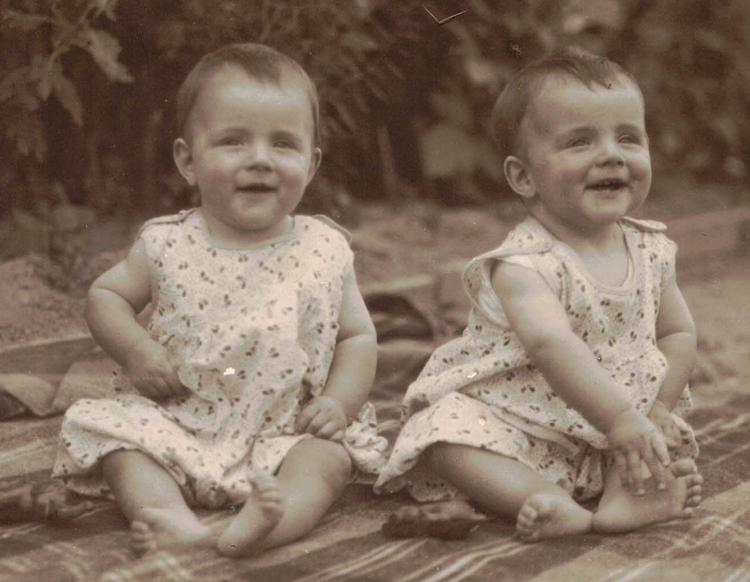23 Nov 2021

HEIDI DOUGLASS | h.douglass@unsw.edu.au
Throughout history, twins have been a source of fascination and wonder – particularly the unique bond they share compared to other sibling relationships.

For academics, twins provide an invaluable source of information, because the similarity in their genetic code allows researchers to pull apart and examine genetic and environmental influences. Twin studies have been influential in the discovery and treatment of diseases and disorders.
Researchers in CHeBA’s Older Australian Twins Study have delved into the lives of nearly 400 sets of twins, including non-identical twin siblings Jan and John Day, and identical twin brothers Jim and Tom Rumery. In a wonderful world of twin match making, Jan became Mrs Rumery when she married Jim.
Jan and John say that being a twin is all about connectedness.
“There was always someone there,” says Jan, who is now 86 years old. “We never had to go looking for playmates.”
Her husband Jim, now 89, shared a similar bond with brother Tom while growing up.
“Jim and I were always together and did things jointly. If one of us had an idea then it was a given that the other would participate.”
Tom Rumery
“They were very close and lived in their own little world,” says Jan.
Both pairs of twins have participated in the Centre for Healthy Brain Ageing’s Older Australian Twins Study since 2007. The study investigates the genetic and environmental differences of twins and specifically how they relate to the spectrum ranging from healthy brain ageing to cognitive decline and dementia.
Study Coordinator Dr Vibeke Catts says that using the twin design helps to determine the proportion of risk of Alzheimer’s disease that results from our genetic makeup, compared with the proportion of risk that results from our lifestyle.
Of the two twin sets, Jim has dementia.
“As his dementia progresses, I find him being far less active,” says Jan. “I try to get him to do puzzles although he lacks concentration.”
“Jim is at a point where he will watch the 5pm news and then watch it again at 6pm and not realise the stories are repeated,” says his wife.
Twin Tom, who lives in north Illawarra by the ocean, doesn’t feel that there were distinct lifestyles differences between him and brother – other than the fact that Jim moved away from the local region to South Australia.


To support his own brain health, Tom believes that eating well is important – which he manages thanks to his wife’s “wonderful meals”. He also engages in complex mental activity such as crosswords and canasta, and has a healthy social life.
Tom has a large family and five great grandchildren who he interacts with regularly.
“I’ve lived in the area most of my life which makes it easy to meet up with friends on a regular basis,” says Tom. “I’m very active with the church community and have a tremendous number of close friends who are also involved.”
At 89, Tom hasn’t slowed down when it comes to keeping himself physically active – and continues to enjoy walking and gardening and plays golf one day a week.
“I feel 59,” says Tom, who attributes this to how well his wife has looked after him.
Jan agrees that it is important to keep active for better brain health, and also challenges her brain by tackling daily puzzles in the newspaper, doing two jigsaw puzzles each night on her iPad and enjoys doing patchwork.
“We don’t drink at all and never go overboard with eating,” says Jan.
All of these various factors assist researchers leading the Older Australian Twins Study to examine the role of mental, social and physical activities in maintaining a healthy brain.
Through this study, it has been shown that twins with varying levels of complex mental activity and social activity perform differently on tests of cognitive function.
Studying twins has also shown that variances in physical health are related to differences in brain health.
Leader of the Older Australian Twins Study and Co-Director of CHeBA, Professor Perminder Sachdev, extends his gratitude to all twins who have participated in the research since 2007.
“It’s an extraordinary commitment and they have contributed significantly to understanding the genetic factors underlying various aspects of cognitive ability, brain structure and also the role of proteins in healthy brain ageing.”
“Only through the study of twins have we been able to establish that approximately 60% of risk of developing Alzheimer’s disease is attributable to our genes, which allows us to advance our research into earlier detection and intervention.”
Professor Perminder Sachdev
Tom, who has been involved in the study for 15 years, says that he has enjoyed being involved.
“Contributing to important research is very fulfilling,” says Tom. To fellow twins he says, “if you are able to do it, do it”.
“It is a benefit to yourself, and a benefit to the people doing the research, but more importantly to future generations.”
Tom Rumery
Jan agrees and encourages Australian twins to “go for it!". “It is definitely worth the time to get involved in any research and help people in the long run,” says Jan.
The Older Australian Twins Study is targeting 1000 twin pairs to join the online study, with most participants to be healthy individuals living in the community.
If you and your twin are interested in participating, you can contact our team for more information twins@unsw.edu.au.
